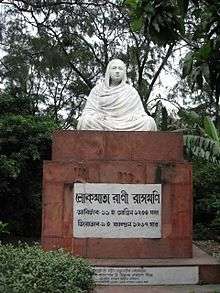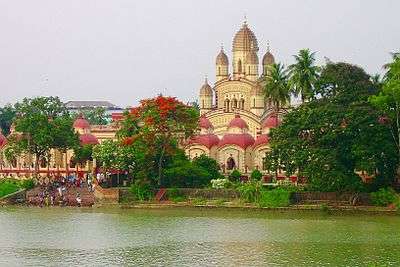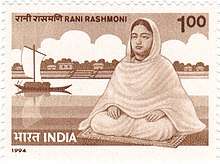Rani Rashmoni
Rani Rashmoni (28 September 1793 – 19 February 1861) was the founder of the Dakshineswar Kali Temple, Kolkata, and remained closely associated with Sri Ramakrishna Paramhansa after she appointed him as the priest of the temple. Her other construction works include the construction of a road from Subarnarekha River to Puri for the pilgrims, Babughat (also known as Babu Rajchandra Das Ghat), Ahiritola Ghat and Nimtala Ghat for the everyday bathers at the Ganges. She also offered considerable charity to the Imperial Library (now the National Library of India), the Hindu College (now Presidency University).[1]

Presently, the Lokamata Rani Rashmoni Mission is situated at Nimpith, South 24 Parganas, West Bengal, 743338, India.[2]
Biography
She was born on 28 September 1793. Her father, Harekrishna Das, lived in Kona village, in present-day Halisahar, North 24 Parganas. Her mother Rampriya devi died when she was just seven years old. Exceptionally beautiful, she was married to Babu Rajachandra Das (Marh) of Janbazar, Kolkata, a member of a wealthy zamindar family, when she was eleven years old. They had four daughters but were not blessed with a surviving son. The daughters were Padmamani, Kumari, Karunamoyee and Jagadamba. Padmamani was married to Ramchandra Ata. Kumari was married to Pairimohan Chowdhury, and she died early, in 1837. Karunamoyee was married to Mathurmohan Biswas (or Madhur-mohan Biswas). She died in 1833 after childbirth, and after her death, her younger sister Jagadamba was married to her husband Mathurmohan Biswas.

After her husband's death in 1836, Rashmoni took charge of the zamindari and finances. She was 49 years in age at that time. She soon proved herself a capable administrator. While the prestige of the zamindari grew, Rani Rashmoni, being very pious from childhood, continued to lead an extremely religious and austere life, befitting a widow in Bengali Hindu society. Rani Rashmoni died on 19 February 1861.
The Rani and her clashes with the British in India became household tales in her time. By blocking the shipping trade on a part of Ganges she compelled the British to abolish the tax imposed on fishing in the river, which threatened the livelihood of poor fishermen. When Puja processions were stopped by the British on the charge that they disturbed the peace, she defied the orders. The British had to withdraw the penalty imposed on her in the face of public opposition and rioting in her support.
Rani Rashmoni also had to her credit numerous charitable works and other contributions to society. She oversaw the construction of a road from Subarnarekha river to Puri for pilgrims. She funded the construction of ghats such as Babughat (in memory of her husband), Ahiritola Ghat and Nimtala Ghat for the daily bathers in the Ganges. She donated generously to the then Imperial Library (now the National Library of India) and Hindu College (now Presidency University). Prince Dwarkanath Tagore had mortgaged a part of his Zamindari in now South 24 Parganas (part of present-day Santoshpur and adjoining areas) to Rani Rashmoni for his passage to England. This part of land which was then a part of the Sunderbans was marshy and almost uninhabitable except for some families of thugs who found the area convenient to stay and venture out for plunders in far away places mounted on stilts. Rani Rashmoni persuaded these families and helped them to build up fisheries in the surrounding water bodies that later turned into large rich bheris. They gradually gave up their 'profession' of plundering and transformed into a community of fishermen. This was a great social reform that the Rani had initiated .
A divine revelation led her to found the famous temple Dakshineswar Kali Temple complex on the banks of the Ganges at Dakshineswar in the North 24 Parganas. Sri Ramakrishna Paramhansa (then known as Gadadhar) was appointed its head priest under her patronage.
Though having such a great spiritual nature the society then had discriminated her. Being born in Chasi-Kaibartta family (Mahishyas) and being a middle-caste Shudra origin,[3] no Brahmin was ready to be the priest in her temple.
Rani Rashmoni's House at Janbazar was venue of traditional Durga Puja celebration each autumn. This included traditional pomp, including all-night jatras (folk theatre), rather than by entertainment for the Englishmen with whom she carried on a running feud. After her death in 1861, her sons-in-law took to celebrating Durga Puja in their respective premises
In popular culture

Rani Rashmoni has also been subject of a biographical film in Bengali language, titled Rani Rasmani (film) (1955), directed by Kaliprasad Ghosh, and wherein lead played by famous theatre personality and actress Molina Devi.[4]
Zee Bangla features a daily soap depicting the life of the illustrious Rani, captioned Karunamoyee Rani Rashmoni which premiered on 24 July 2017 and is telecasted daily.[5][6]
Monuments
- An avenue in Esplanade, Kolkata is named after her as Rani Rashmoni Avenue, where her statue is also located.
- A road is named after her as Rani Rashmoni Road near her ancestral house at Janbazar, Kolkata.
- A road is named after her as Rani Rashmoni Road at Dakshineshwar.[7]
- The Department of Post of Government of India issued a postage stamp to memorialise the bicentennial of Rani Rashmoni in 1993
- A Ferry Ghat known as Rani Rashmoni Ghat has been built for ferry services in Barrackpore, West Bengal and in Hooghly, West Bengal (just after the Hooghly District Correctional Home)
- One of the 5 Fast Patrol Vessels of Indian Coast Guard has been named after Rani Rashmoni. It was commissioned in June 2018 and will be based in Visakhapatnam (indigenously built by Hindustan Shipyard).
Further reading
References
- Rashmoni Devi Dakshineswar Kali Temple website.
- NGO's working with Environment Department Archived 31 January 2009 at the Wayback Machine Environment Department, Govt. of West Bengal.
- Nicholas, Ralph W (2003). Fruits of Worship: Practical Religion in Bengal. Orient Longman Ltd. p. 53. ISBN 978-8180280061.
- Rani Rashmoni on IMDb
- "Official page of Karunamoyee Rani Rashmoni". www.zee5.com.
- "Rani Rashmoni beats popular shows on TV; rules the TRP chart". timesofindia.indiatimes.com.
- Skywalk to adorn Dakshineswar soon | Kolkata News – Times of India. Articles.timesofindia.indiatimes.com (22 April 2012). Retrieved on 2018-11-30.